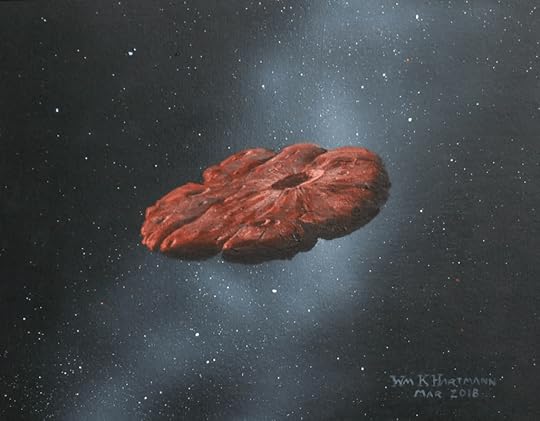Retrieving samples from Exoplanets
The first confirmed interstellar object to pass through our solar system was 1I\ʻOumuamua, and from the outset, it was clear this was not a comet or even an asteroid, but rather some kind of fragment (possibly from a planet or moon).

As more information came to light, though, the artist’s renditions became less sci-fi and more scientifically plausible, with the latest explanation being that ‘Oumuamua was probably blown off the surface of a minor planet roughly the size of Pluto.

Based on the degree of erosion due to cosmic rays, scientists were even able to estimate ‘Oumuamua’s approximate age, and calculate that it took roughly 400 million years to reach our solar system. Given that it is moving at 26 km/s (16 miles per second) and has been traveling for hundreds of millions of years, it could have originated from anywhere within about 30,000 light-years from Earth, or roughly a third of the galaxy!

A slight discrepancy between its motion and the influence of gravity led scientists to realize there was some form of outgassing, making it at least comet-like, and propelling it along, but this didn’t stop Harvard astrophysicists and alien hunter Avi Loeb from claiming it was an alien spacecraft (sigh).
As the difference was 17 m/s or about 40 mph, it’s hardly a warp drive. The only conclusion that I can reach is that if ‘Oumuamua is an alien spacecraft, its engines are worse than ours!

And that brings us to 3I\Atlas, the latest interloper passing through our solar system. Like 1I\ʻOumuamua, there’s intense speculation from Avi Loeb about it being an alien spacecraft (sighs again). Loeb even invented the Loeb scale for deviations from naturally occurring objects (conveniently and unabashedly named after himself) and rates it a 4 out of 10. If it were a movie on IMDB, it would rate alongside Madame Web and Inspector Gadget.
There are some great articles about 3I\Atlas that are worth reading, but there’s also a lot of trash.

The most curious thing about 3I\Atlas is that it is outgassing nickel and cyanide, which is not what we would associate with an icy comet or an asteroid, suggesting that, like 1I\ʻOumuamua, its origins are more complex than usual.
At the moment, the current working hypothesis is that 3I\Atlas could have originated in a sedimentary basin on an exoplanet that might have once hosted life! 3I\Atlas could have been blasted off its home world by an impact similar to the one that wiped out the majority of the dinosaurs!

The Chicxulub impact that killed the dinosaurs definitely launched material into space. Rocks several meters wide would have made it to the Moon and Mars. And this brings up an interesting point: only a tiny fraction of the material thrown up in impacts like this escape into space, and these fragments tend to be small, so objects the size of 1I\ʻOumuamua and 3I\Atlas would have come from significantly BIGGER impacts! Also, it means that although we’re catching things the size of ʻOumuamua and Atlas, we’re probably missing the more numerous small fragments!
Whether fragments from Chicxulub could have escaped the solar system is difficult to determine, but they could have received natural gravity assists and soared off toward other star systems. If so, while we’re watching 3I\Atlas soar through our solar system, after 65 million years, aliens up to 9,000 light-years away could be tracking rocks that hold dinosaur fossils as they tumble through the dark void of space!
But… Hold the phone…
We will undoubtedly learn more about ʻOumuamua and Atlas so we need to be careful about drawing conclusions too soon. For now, it’s an exciting possibility, but the real takeaway here is that we’ve had three confirmed interstellar objects pass through our solar system in eight years, and at least two of them appear to be fragments of a significant astronomical body in another star system (ie, not a regular asteroid or a comet). That is fantastic!
This means—if we get our act together and develop a robotic interceptor spacecraft, have it sitting in orbit ready to go—we could collect samples from worlds around OTHER stars before we get samples from Mars! Think about how astonishing that would be… in all likelihood, we won’t be able to achieve interstellar flight for centuries if not millennia to come, but we don’t have to. Exoplanet samples are being delivered to our door by cosmic USPS.
This isn’t science fiction. We know how to do this. We’ve already done this several times before. We’ve been doing this since NASA’s Stardust mission in 2006. We’ve done this four times, and a fifth mission by the Chinese is already underway.
The real point to take from 1I\ʻOumuamua and 3I\Atlas is that we can sample exoplanets without leaving our own solar system! I’m sure someone at NASA, JAXA, ESA, CNSA, etc is already drawing up plans to catch the next 3I\Atlas.

In the meantime, if you’re interested in speculative (hard) science fiction about interstellar comets, check out my novel Gold Rush, and if you’re curious about what we might find on the shattered remnants of an exoplanet, check out The Darkness Between the Stars. Who knows, maybe one day this kind of science fiction will become science fact!




